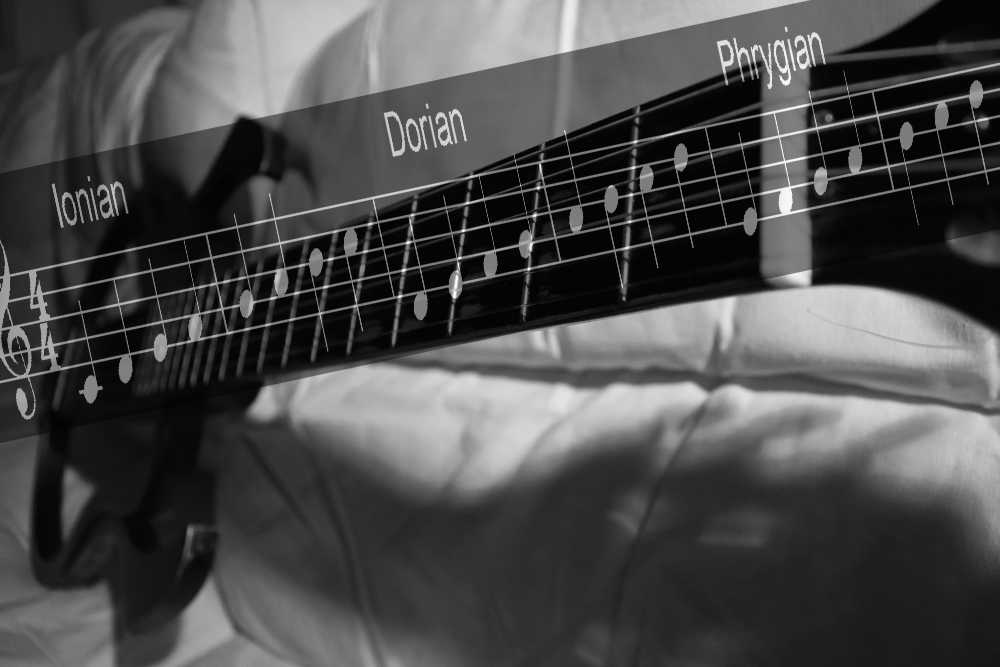
Modes Made Musical
This is the final post from a series digging into the major scale modes and their sound. It will focus on applying the theory and the practical fretboard suggestions from the last two posts and highlight getting the sound into your ear: A.K.A ear training.
This lesson is going to concentrate on the aural aspect of modes, and how to make sense of their sound; and like Sherlock Holmes said:
“The game is afoot!”
If you missed the first lesson, the one with all the theory and explanation stuff in it, here is the link: Modes Made Manageable.
Modes made what now?
So following on from the last lessons we learnt what a mode is and two different ways of thinking about them and how to construct them: from brightest to darkest. Carrying on from that solid point of knowledge we are going to delve under the hood into their sound: what makes Dorian so sweet and Locrian so dark!
Being able to hear these you will need to focus on the notes that define each mode. No reason to panic though it really is only two notes per scale, their color tones. One of those two notes remains the same through out each: the 3rd. As this note defines whether the mode is major or minor and is important. The other note is the modal coloring, the sharp 4 or flat second and the rest! Sound interesting? Lets delve in.
Major Modes
The three major modes (major 3rd in all of them) up first, as their sound is easily digested and again these rest on reordering the modes however this time using each as a comparison to the other to get the sound in your ear.
The notes to hone in on are: sharp 4 and flat 7 compared to the major scale.
So now here is the first key bit of info for these modes to work aurally.
- They need the root of the mode underneath, made explicit, in the bass.
So D dorian would need a D note underneath it, or better a D min chord. The G mixolydian would need a G note under it, or better a G7 chord. So here we have C lydian, ionian and mixolydian. They need, like really- really need, the C underneath them for their magic to work. Other wise you are just playing the major scale. Not Cool!
Secondly concentrate on the altered notes, #4 & b7, respectively. Otherwise you are just playing a major scale. So for lydian, only play the first four or five notes, for mixolydian the last four or five. This is called targeting and it is what you would when improvising.
Jazz players do this a lot in their lines. If you wish to get to grips with this sort of thinking and playing we highly recommend one esteemed guitarist: Matt Warnock( &.com); he and his site is one of the best websites out there for learning jazz, its practical bits and its theory.
Minor Modes
The three minor modes (minor 3rd in all of them) next, as their sound is again easily digested by reordering the modes and this time using each as a comparison to the other to get the sound in your ear.
Looking above you will see that the notes that are the same throughout each scale have been reduced in size. Also not that the main markers for any chord or scale: 3rd and 7th, are the same throughout! So how the hell do you tell an aeolian from a phrygian? Easy!
Those color tones.
So starting from the top:
- the 6ths change between the dorian and aeolian
- the 2nds change from aeolian to phrygian.
Again they need the root of the mode to be underneath them and only one note needs to concentrated on to really nail their sound. So for Dorian its the natural 6th, for Aeolian its the minor 6th and phrygian its the flat second. Hone in on the scale fragments that have those notes as these are the color tones.
The darkest mode
And what about that dastardly sounding locrian mode? Simple, from your phrygian mode, it is the 5th note that dips down. See for yourself, play through the two scales!
Recap
This method of hearing the modes is based on a process of elimination, a bit like Sherlock Holmes. When you compare the modes, as they are grouped into a major or minor sound. Take away the notes that they all share and see what you are left with. Then add in this crucial bit of information: you only need a 3rd or 7th to outline a chord. So add in the notes that are different, the sharp 4ths or flat 7ths and you have the aural answer to being able to spot modes.
Education never ends, Watson!
Now unfortunately this does not stop here as there are literally hundreds of modes. In western music alone we use 3 major scales and (mostly) two pentatonics. You add all their modes together and you get….?
31 modes
But as we have hopefully highlighted in this lesson, you do not need to know all the notes, just the notes that are different between each scale: their color tones. This is useful because you are relying on knowledge already gained through scale practice – hopefully, and just adjusting it to filter out the notes that remain the same, highlighting the differences.
Learning the Sound with Pictures
That is a lot of information to take in. So here is another suggestion for learning the sound: with some creative visualization.
What does its sound remind you of?
- Aeolian – sad and in space
- Lydian – warm sunshine or lost
- Phrygian – flamenco or Aladdin
Sky is the limit with this sort of identification and learning, just make it personal and it will work.
Practice on the guitar
The guitar has the advantage of having open strings. So I suggest, to begin with, play the low open string as a drone note. Pick string one and play up and down it moving from mode to mode. Concentrate getting it into your aural memory. Play around and focus in on the notes that are different. This is a called:
And one of the favorite compositional moves of Joe Satriani, Steve Vai and well loads of others, Bach included! Check out Satch’s most famous tune that uses this. (Hint: The pitch-axis bit is in the tapping section!)
Mode Chart
Below is the mode chart with all the color tones made big and all the other notes made small. Nothing more nothing less.




